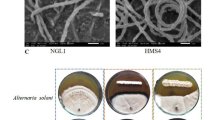Abstract
Coniochaeta ligniaria NRRL30616 is an ascomycete that grows with yeast-like appearance in liquid culture. The strain has potential utility for conversion of fibrous biomass to fuels or chemicals. Furans and other inhibitory compounds in lignocellulosic biomass are metabolized by NRRL30616, facilitating subsequent microbial fermentation of biomass sugars. This study undertook initial characterization of the genetic system of C.ligniaria NRRL30616. Transformation using hygromycin as a dominant selectable marker was achieved using protoplasts generated by incubating cells in 1% (v/v) β-mercaptoethanol, followed by cell wall-digesting enzymes. Thirteen chromosomes with an estimated total size of 30.1 Mb were detected in C. ligniaria. The GC content of chromosomal DNA and of coding regions from cDNA sequences were 49.2 and 51.9%, respectively. This study is the first report of genome size, electrophoretic karyotype, and transformation system for a member of the Coniochaetales.



Similar content being viewed by others
References
Atkins SD, Mauchline TH, Kerry BR, Hirsch PR (2004) Development of a transformation system for the nematophagous fungus Pochonia chlamydosporia. Mycol Res 108:654–661
Beadle J, Wright M, NcNeely L, Bennet JW (2003) Electrophoretic karyotype analysis in fungi. Adv Appl Microbiol 53:243–270
Cabañas MJ, Vázquez D, Modolell J (1978) Dual interference of hygromycin B with ribosomal translocation and with aminoacyl-tRNA recognition. Eur J Biochem 87:21–27
Damm U, Fourie PH, Crous PW (2010) Coniochaeta (Lecythophora), Collophora gen. nov. and Phaeomoniella species associated with wood necroses of Prunus trees. Persoonia 24:60–80
Davies B (1985) Factors influencing protoplast isolation. In: Peberdy JF, Ferenczy L (eds) Fungal protoplasts: application in biochemistry and genetics. Marcel Dekker, New York, pp 45–71
García D, Stchigel AM, Cano J, Calduch M, Hawksworth DL, Guarro J (2006) Molecular phylogeny of Coniochaetales. Mycol Res 110:1271–1289
Gerhardt P, Murray RGE, Costilow RN, Nester EW, Wood WA, Krieg NR, Phillips GB (1981) Manual of methods for general bacteriology. American Society for Microbiology, Washington DC
Gregory TR, Nicol JA, Tamm H, Kullman B, Kullman K, Leitch IJ, Murray BG, Kapraun DF, Greilhuber J, Bennet MD (2007) Eukaryotic genome size database. Nucleic Acids Res 35:D332–D338
Gritz L, Davies J (1983) Plasmid-encoded hygromycin B resistance: the sequence of hygromycin B phosphotransferase gene and its expression in Escherichia coli and Saccharomyces cerevisiae. Gene 25:179–188
Holloman DW, Butters JA, Barker H (1997) Tubulins: a target for antifungal agents. In: Bentley PH, O’Hanlon PJ (eds) Anti-infectives: recent advances in chemistry and structure–activity relationships, Ch 11. Royal Society of Chemistry, London
Horng JS, Chang PK, Pestka JJ, Linz JE (1990) Development of a homologous transformation system for Aspergillus parasiticus with the gene encoding nitrate reductase. Mol Gen Genet 224:294–296
Huhndorf SM, Miller AN, Fernández FA (2004) Molecular systematics of the Sordariales: the order and the family Lasiosphaeriaceae redefined. Mycologia 96:368–387
Hynes MJ, Corrick CM, King JA (1983) Isolation of genomic clones containing the amdS gene of Aspergillus nidulans and their use in the analysis of structural and regulatory mutations. Mol Cell Biol 3:1430–1439
Johnson JL (1994) Similarity analysis of DNAs. In: Gerhardt P, Murray RGE, Wood WA, Krieg NR (eds) Methods for general and molecular bacteriology. American Society for Microbiology, Washington DC, pp 656–682
Kullman B, Tamm H, Kullman K (2005) Fungal genome size database. http://www.zbi.ee/fungal-genomesize. Accessed 21 October, 2010
López MJ, Nichols NN, Dien BS, Moreno J, Bothast RJ (2004) Isolation of microorganisms for biological detoxification of lignocellulosic hydrolysates. Appl Microbiol Biotechnol 64:125–131
Nichols NN, Sharma LN, Mowery RA, Chambliss CK, Van Walsum GP, Dien BS, Iten LB (2008) Fungal metabolism of fermentation inhibitors present in corn stover dilute acid hydrolysate. Enzyme Microbial Technol 42:624–630
Nichols NN, Dien BS, Cotta MA (2010) Fermentation of bioenergy crops into ethanol using biological abatement for removal of inhibitors. Bioresour Technol 101:7545–7550
Orbach MJ, Porro EB, Yanofsky C (1986) Cloning and characterization of the gene for β-tubulin from a benomyl-resistant mutant of Neurospora crassa and its use as a dominant selectable marker. Mol Cell Biol 6:2452–2461
Palmqvist E, Hahn-Hägerdal B (2000) Fermentation of lignocellulosic hydrolysates. I. Inhibition and detoxification. Bioresour Technol 74:17–24
Sambrook J, Russell DW, Irwin N, Janssen KA (2001) Molecular cloning. A laboratory manual, 3rd edn. Cold Spring Harbor Laboratory Press, New York
Staben C, Jensen B, Singer M, Pollock J, Schechtman M, Kinsey J, Selker E (1989) Use of a bacterial hygromycin B resistance gene as a dominant selectable marker in Neurospora crassa transformation. Fungal Genet Newsl 36:79–81
Storck R (1966) Nucleotide composition of nucleic acids of fungi. II. Deoxyribonucleic acids. J Bacteriol 91:227–230
Unkles SE, Campbell EI, Carrez D, Grieve C, Contreras R, Fiers W, van den Hondel CAMJJ, Kinghorn JR (1989) Transformation of Aspergillus niger with the homologous nitrate reductase gene. Gene 78:157–166
Weber E (2002) The Lecythophora–Coniochaeta complex I. Morphological studies on Lecythophora species isolated from Picea abies. Nova Hedwigia 74:159–185
Weber E, Görke C, Begerow D (2002) The Lecythophora–Coniochaeta complex II. Molecular studies based on sequences of the large subunit of ribosomic DNA. Nova Hedwigia 74:187–200
Acknowledgments
We thank Sarah E. Frazer, Kristina M. Glenzinski, and Rhonda L. Zeltwanger for their technical assistance.
Author information
Authors and Affiliations
Corresponding author
Additional information
Communicated by H. Osiewacz.
Mention of trade names or commercial products in this article is solely for the purpose of providing specific information and does not imply recommendation or endorsement by the US Department of Agriculture. USDA is an equal opportunity provider and employer.
Nucleotide sequence data reported are available in the DDBJ/EMBL/GenBank databases under accession numbers HQ197357 and HS107146-HS107191.
Rights and permissions
About this article
Cite this article
Nichols, N.N., Szynkarek, M.P., Skory, C.D. et al. Transformation and electrophoretic karyotyping of Coniochaeta ligniaria NRRL30616. Curr Genet 57, 169–175 (2011). https://doi.org/10.1007/s00294-010-0332-0
Received:
Revised:
Accepted:
Published:
Issue Date:
DOI: https://doi.org/10.1007/s00294-010-0332-0




